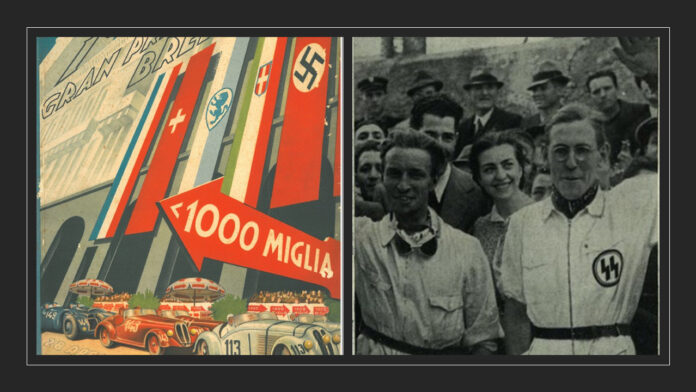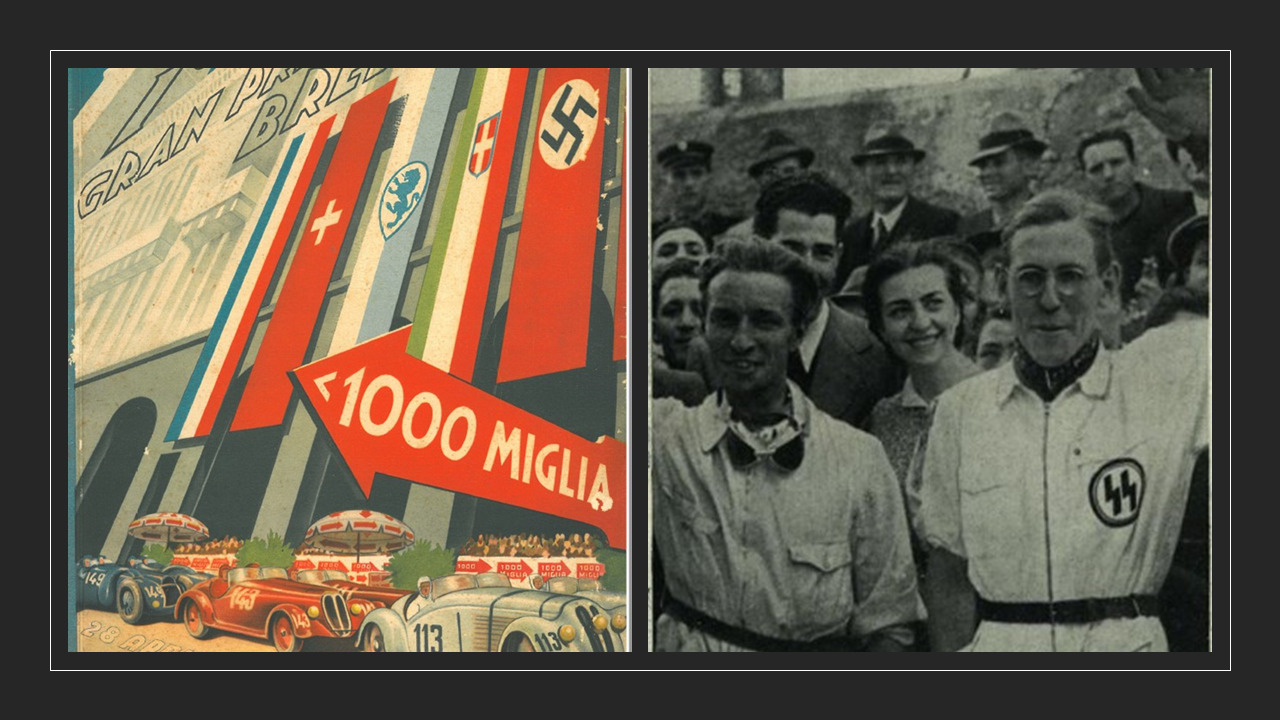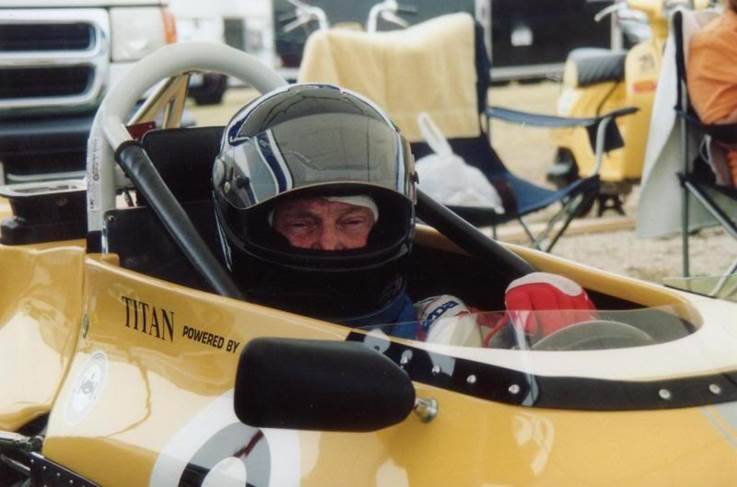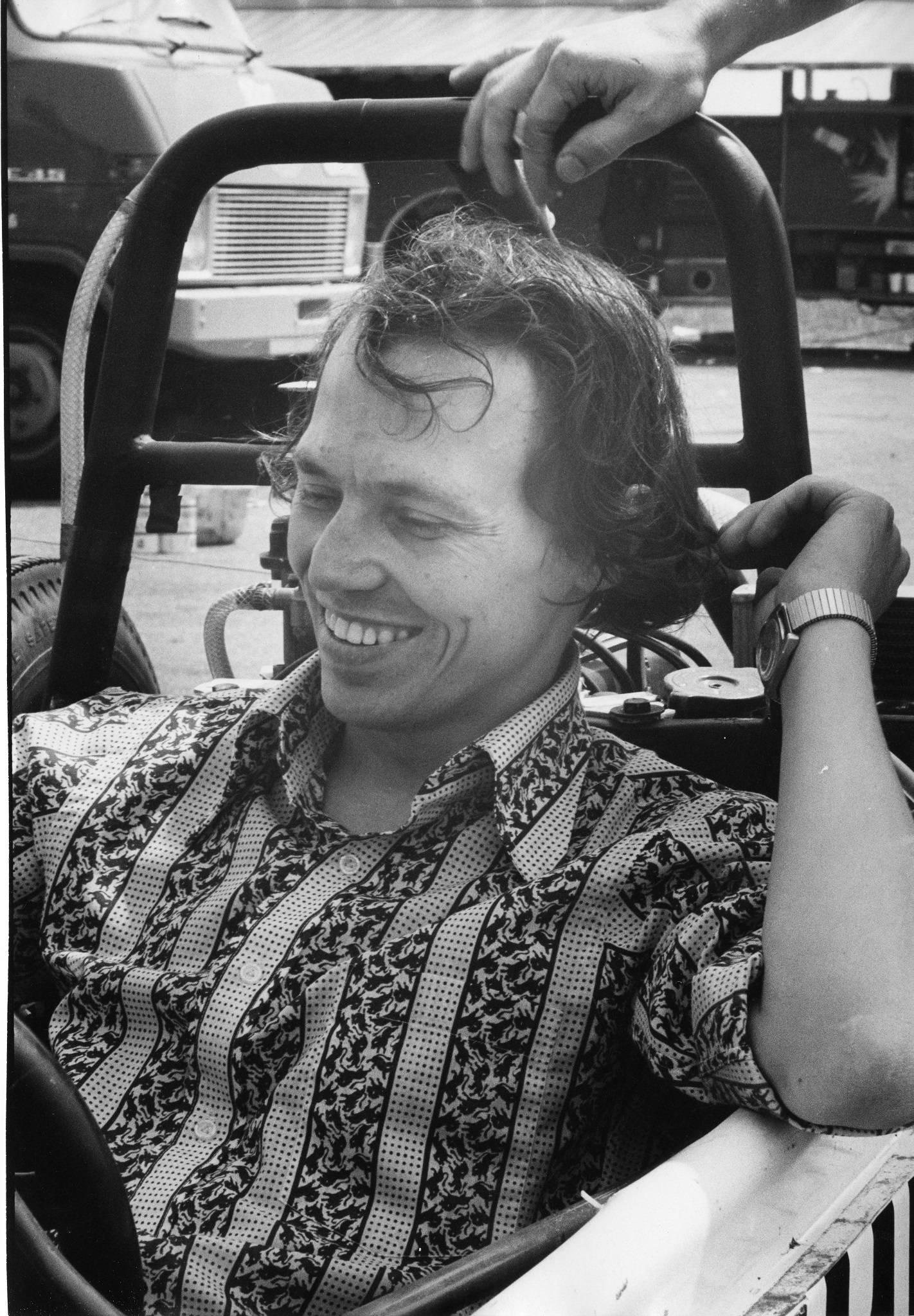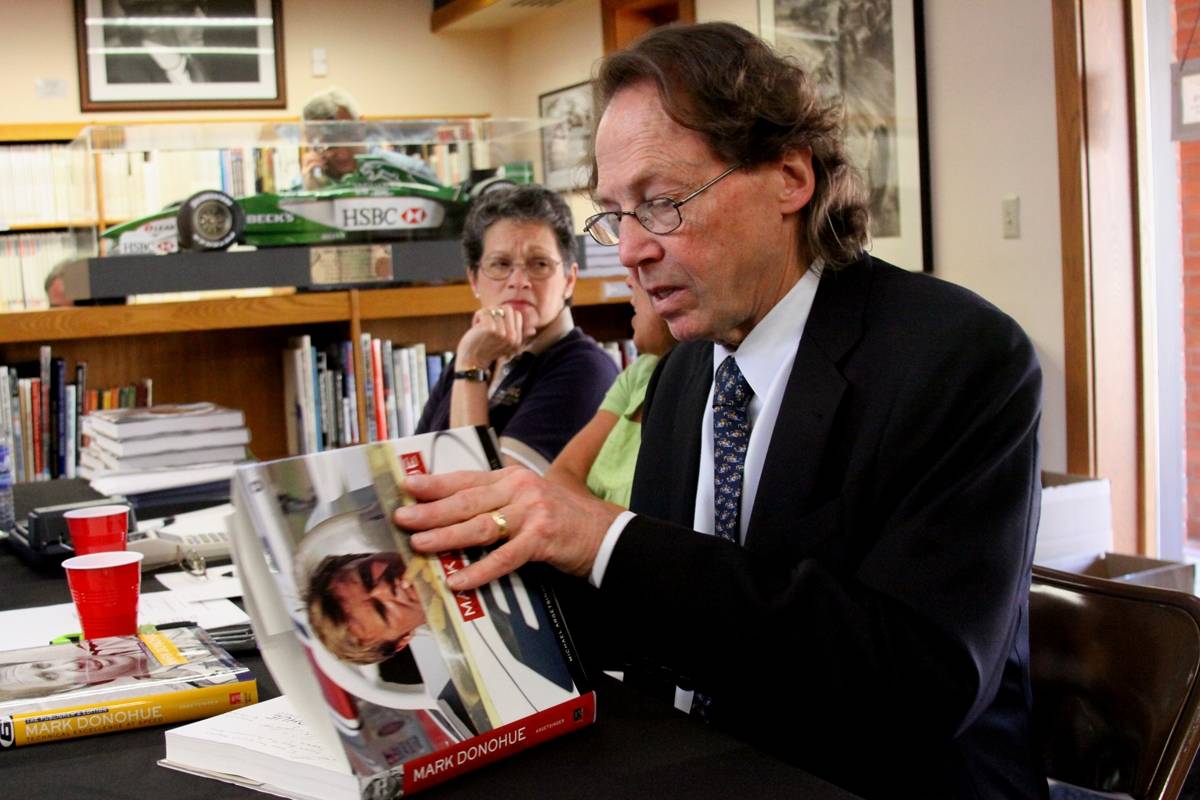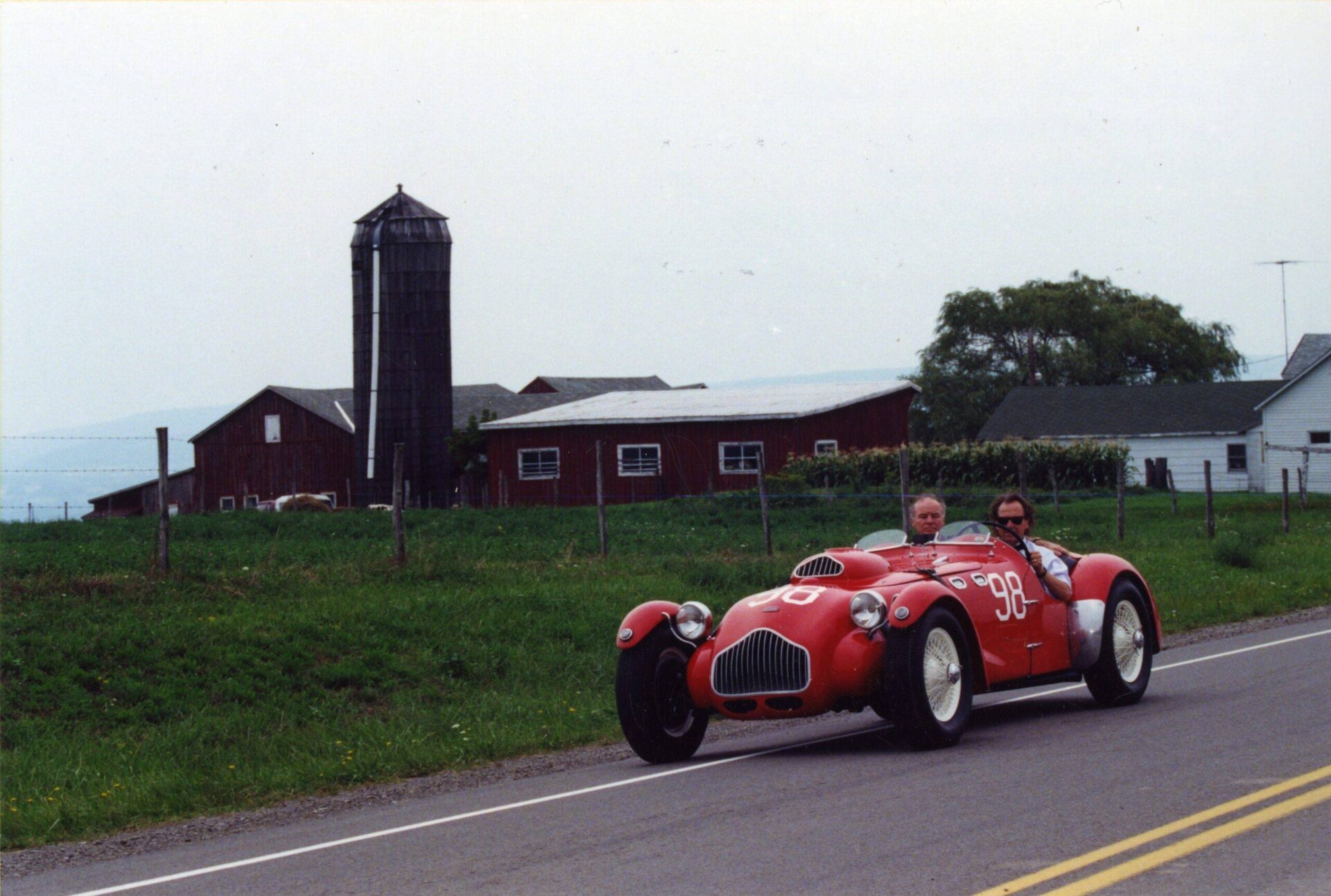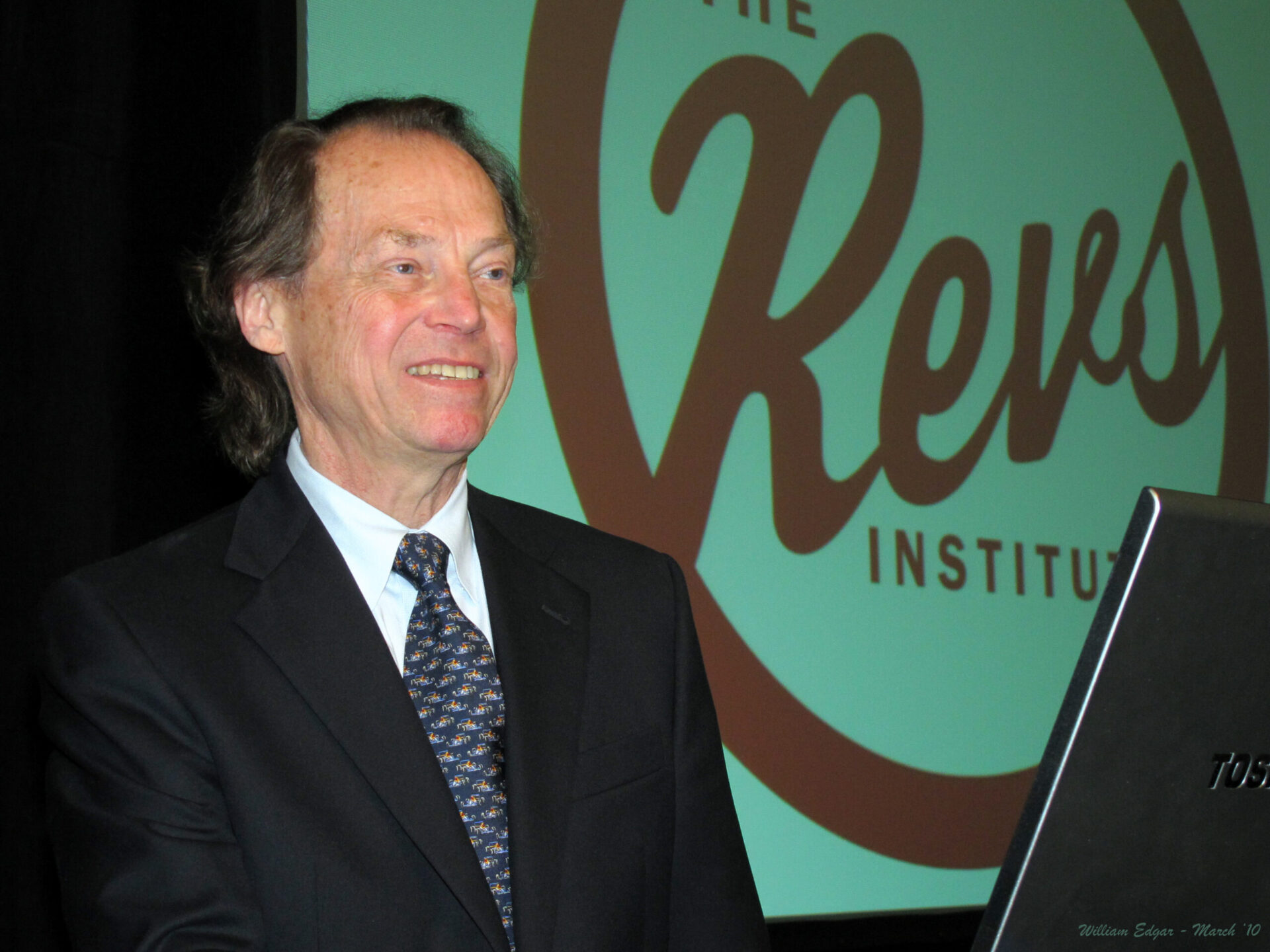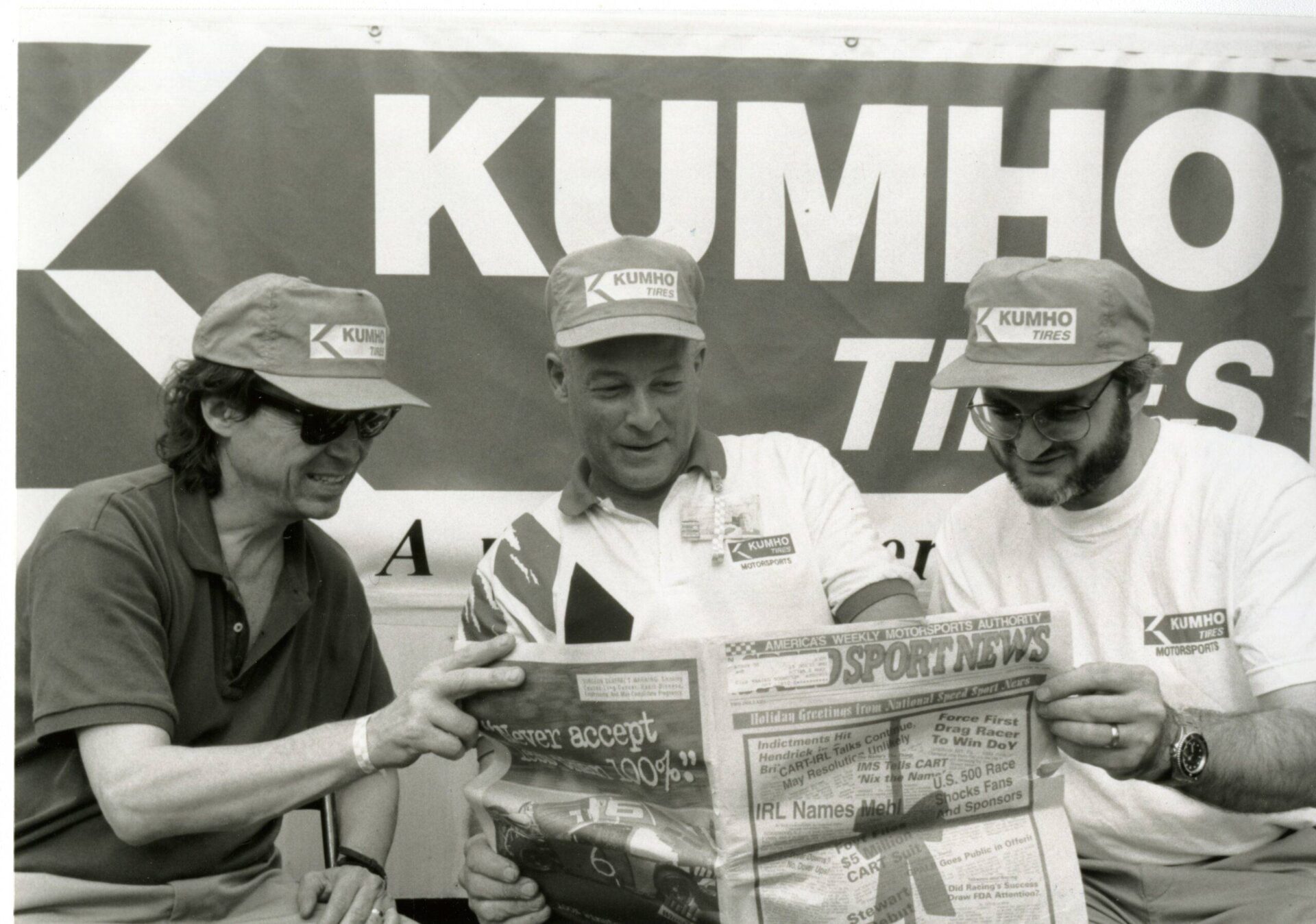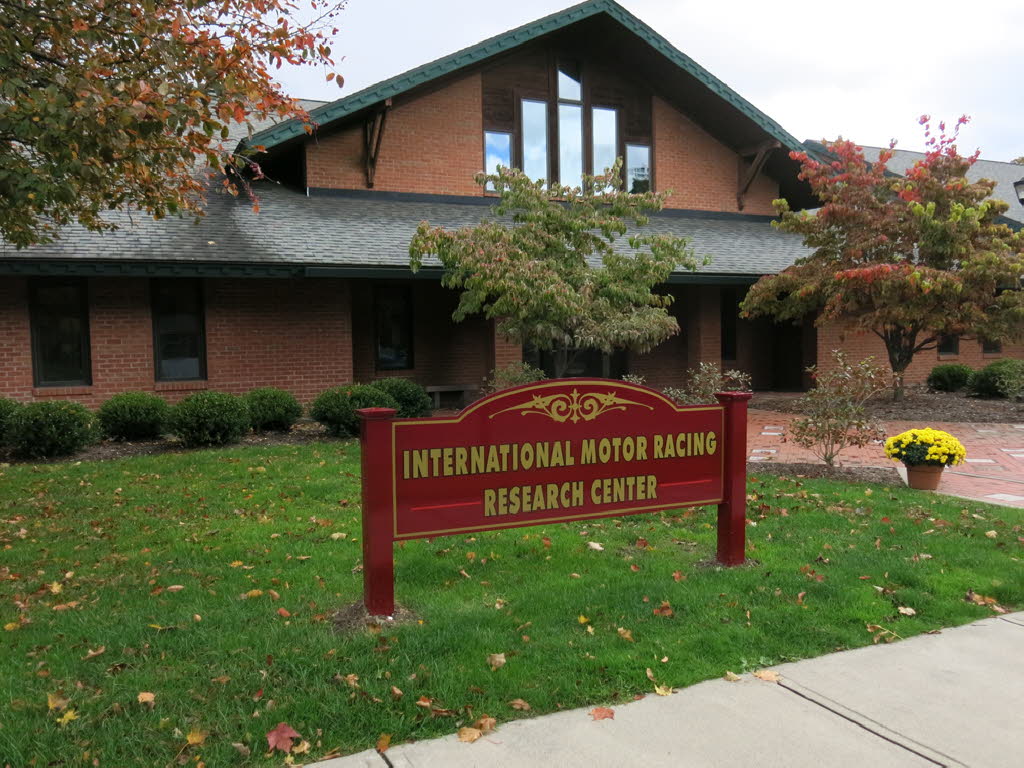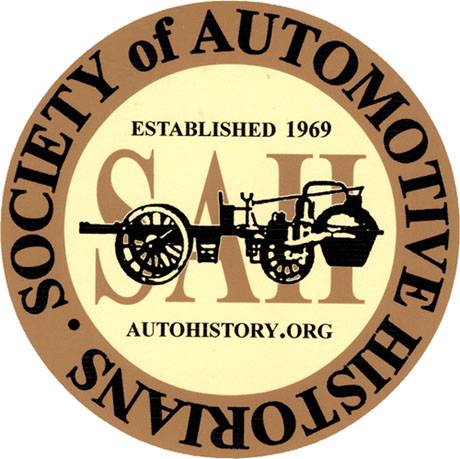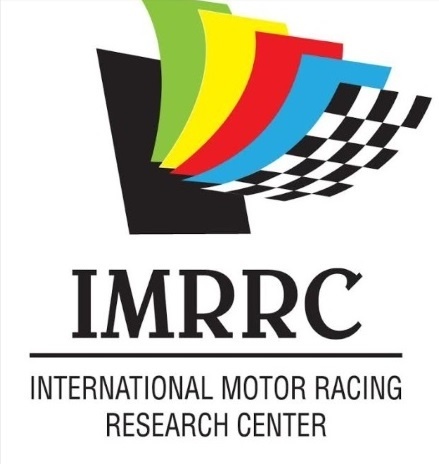The 1940 Mille Miglia is an anomaly in the long history of the race. The previous classic editions, held between 1927 and 1938, were run on the thousand-mile figure-of-eight open road course covering half of Italy. During that time, it had become Italy’s most important motor race and one that was exploited by Mussolini’s Fascist regime. After a major tragedy in 1938, the race was reinvented in 1940 and bore scant resemblance to the original. This paper examines how the race was used by the regime to exalt the Axis alliance while at the same time making great efforts to link it to its more illustrious preceding editions.
Bio
Paul Baxa is professor of history at Ave Maria University in Florida. Parts of his most recent book, Motorsport and Fascism: Living Dangerously (Palgrave Macmillan, 2022) have been presented at past Argetsinger Symposia. He was privileged to have presented at the first symposium in 2015.
Notes
Transcript
[00:00:00] Break/Fix’s History of Motorsports series is brought to you in part by the International Motor Racing Research Center, as well as the Society of Automotive Historians, the Watkins Glen Area Chamber of Commerce, and the Argettsinger family.
The Axis GP, the reinvention of the Mille Miglia in 1940 by Paul Baxa. Paul Baksa is a professor of history at Ave Maria University in Florida. Parts of his most recent book, Motorsport and Fascism, Living Dangerously, published by Palgrave Macmillan in 2022, the 1940 Mille Miglia is an anomaly in the long history of the race.
The previous classic editions held between 1927 and 1938 were run on a thousand mile figure of eight open road course covering half of Italy. During that time, it had become Italy’s most important motor race and one that was exploited by Mussolini’s fascist regime. After a major tragedy in 1938, the race was reinvented in 1940 and bore scant resemblance to the [00:01:00] original.
This paper examines how the race was used by the regime to exalt the Axis Alliance while at the same time making great efforts to link it to its more illustrious preceding additions. Our next speaker, Professor Paul Baxham of Amory University. I have a great appreciation for Paul, and I’m glad he’s back, and I’m looking forward to this presentation.
So, Paul, thank you. Thank you, Don. It’s a great pleasure to be back. It’s been about five years. I’m really happy to be back with you. Again, it’s great to see how the symposium has grown so much over the years. During the running of the 1938 Mila Mila, an accident killed ten spectators, including several children.
One day later, the Italian newspapers ran a press release from the Italian government that read quote with the 12th edition Which has cost many lives the cycle of the Mille Miglia on the ordinary roads of metropolitan centers is finished With this short statement Italy’s most important motor race seemed to be over first run in [00:02:00] 1927 the Mille Miglia had quickly become one of Italy’s three major sporting events next to the cycling Giro d’Italia and the soccer championship Unlike these other events, the Mille Miglia was a unique product of the fascist era that claimed to embody fascist values and played a key role in promoting Mussolini’s regime as one of modernity and technological progress.
The sudden pulling of the plug thus came as a surprise, considering that ten years previously, a similar accident during the Italian Grand Prix at Monza, that killed over 20 spectators. On that occasion, the fascist regime rejected calls to ban motor racing, claiming that accidents and loss of life were the price paid for progress and a reminder that fascism was all about living dangerously.
By 1938, however, circumstances had changed. Back in the 1920s, Mussolini was in the process of installing a dictatorship whereby fascism was promoted through its violent and dynamic nature. Motorsport proved [00:03:00] an effective vehicle for fascists eager to demonstrate the new Italy that they wanted to create.
In 1938, fascism was now in its regime phase, where it needed to protect its firm grasp on Italians. One of the regime’s persistent claims was that the Mille Miglia proved fascism’s ability to bring discipline and order to the Italian peninsula. The fact that the race had never had such an accident in its previous editions was a point of pride for a regime that was now firmly established.
The accident at Bologna threatened to give the lie to these claims. Therefore, the race needed to be axed. In a certain sense, the Mille Miglia was a victim of its own success. The fact that no serious accident had ever occurred before 38 allowed the regime to boast that fascism had imposed discipline on Italians and that the new roads facilitated increasingly powerful racing cars to compete safely on open roads.
When the race was first conceived in 1927, it was intended [00:04:00] to be a test of endurance for Italian made touring cars. The organizers hoped that the race would not only stimulate the Italian automotive sector, But also encourage the state to keep improving the country’s road network. It didn’t take long for the event to become all about speed and the latest high performance technology.
As early as the second edition in 1928, several cars were supercharged. Technology that most automakers were still reluctant to use for regular touring cars. By the mid 1930s, the winning cars of the Mille Miglia were nothing more than thinly disguised Grand Prix cars. As the race grew in popularity, it became a contest between Grand Prix aces like Tadzio Nuvolati and Achille Varzi, driving competing Alfa Romeos.
In the meantime, fascism’s cult of speed and progress was given full expression in a race that attracted celebrities and political figures. The fascist party secretary was the honorary starter, and key figures in the regime appeared at the [00:05:00] Rome checkpoint. Mussolini donated a cup in his name for the driver able to cover the Brescia to Rome leg in the fastest time.
In 1936, defying the League of Nations embargo on Italy due to the Ethiopian War, the race was promoted in the service of autarchy. with some cars using alternative fuels. The sudden death of the 1938 thus ended an event that was important to fascism’s self image and a blow to Italian motorsport at a time when Italian cars were being trounced on the Grand Prix circuits by the Silver Arrows.
Therefore, the Mille Miglia had to be revived in some new shape or form. An alternative was floated for a race to be run in the Italian colony at Libya, but this would have taken it far away from Brescia. Ultimately, a solution was found to hold a nine lap race on closed public roads linking Brescia.
Cremona and Monto on a circuit measuring 165 kilometers or 102.5 miles. The day chosen for the race was [00:06:00] April 28th, 1940, and the runup to the event the organizers needed to convince the Motorsport community that this edition, despite its obvious difference to the previous races, was a new and revived mil milia.
It also needed to persuade the regime that the fascist values embodied in the classic event would be maintained. In short, the Mille Miglia had to be reinvented as a sporting and as a political event. The 1940 Mille Miglia is an anomaly. To begin with, it was officially called the first edition of the Gran Premio di Brescia, which you can see on the poster of the event.
A title that could easily lead people to believe that this was an inaugural race and not a continuation of a classic race. Furthermore, one of the race’s original organizers, Giovanni Canestrini, refused to be involved with this new event. As well as being one of the legendary four musketeers who invented the race, Canestrini was also Italy’s leading motorsport journalist.
It [00:07:00] was largely through his reporting in the Gazzetta dello Sport that the Mille Miglia was elevated to legendary status. Canestrini never considered the 1940 race to be a legitimate Mille Miglia, writing in his 1967 memoir that holding the race on a closed course betrayed the spirit of the classic event.
Despite this denunciation, Canestrini did include the results of the race in the appendix of his book, as well as some photographs, thus recognizing it as an official millimilia, despite his own personal views. Canestrini’s views contributed to the debate on what constituted the essence of the millimilia.
For him, it was the figure of an open road course that covered half of Italy. Many in Italy would have agreed that this was the race’s most distinctive feature. The challenge for the organizers was to convince the public that the new edition was legitimate despite the sacrificing of its most notable feature.
This would prove difficult since [00:08:00] the race’s original justification in 1927 was that the Mille Miglia was reviving the old open road races that had ended with the disastrous Paris Madrid race of 1903. It didn’t help matters that the official race program since the early 30s included large inserts on the famous cities that the race passed through, such as Florence, Rome, Bologna, and Venice.
The Mille Miglia had effectively become motorsports version of the cycling Giro d’Italia, the only difference being that the course did not change much from year to year. Photographs of the race included important landmarks, such as the Piazza Michelangelo in Florence or the Piazzale Milvio in Rome.
The course also served to highlight public works projects carried out by the fascist regime, such as the Littorio Bridge, which connected Venice to the mainland. The spectacular complex of fascist architecture around the Piazza Vittoria. The ill fated 1938 race even [00:09:00] included a lengthy stretch of the new Autostrada connecting Florence to the sea, a feature that accounted for the sharp increase in that race’s average speed.
Like the classical editions, the new race was also designed as an international event, a fact complicated by the circumstances of war. In the past, the race enjoyed entries from Germany, Great Britain, and France, among others. In the spring of 1940, Germany was at war with both Britain and France, and Fascist Italy technically belonged to the Axis, albeit in a non combatant role.
Therefore, it was a difficult proposition to get those countries to send participants. Moreover, the German entries put intense pressure on the organizers to ban British and French cars from the race. Determined to maintain the race’s international status, the Brescian Automobile Club withstood the pressure and accepted two French DeLage entries.
[00:10:00] Although no British entries materialized, the esteemed motorsport writer W. O. Bradley, a fan of the race from its beginnings, showed up, only to face harassment from the Germans who were staying in the same hotel. So how did the 1940 edition of the Mille Miglia become part of the official canon of the classic race, despite its anomalous character?
As I’ve argued in my book on fascism and motorsport, the Mille Miglia was a fascist artifact. Indeed, fascism was imprinted into the DNA of the race. From its origins, fascism indulged in a cult of speed and danger. A fetish for fast cars was common to both cultural strands that fed into Mussolini’s movement, futurism and Gabriele Danunzio’s decadentism.
The strong cult of speed was reflected in the regime’s enthusiastic support for motor racing, a fact appreciated by foreign observers like Bradley, who praised Mussolini for making [00:11:00] races like the Mille Miglia a reality. He also praised the regime for disciplining Italians, right? Imagine that coming from a British writer in a British magazine.
The Mille Miglia served fascism in several ways. First, it was a showcase for Italian industry. Second, it provided the regime an opportunity to brag about the discipline of the Italian people and to highlight its public works projects. Third, it became a vehicle to propagandize the regime’s initiatives.
such as autarky or national economic self sufficiency. Fourth, it transformed half of Italy into a giant autodrome where the world’s fastest sports cars could shatter speed records and indulge in the cult of speed on ordinary roads. Finally, the regime could claim that it was returning motorsport back to its heroic, pioneering days of the open road, city to city races, when Italian cars were often major protagonists.
And it could do all [00:12:00] this without the massacres of those previous races, until 1938, of course. The task of the Royal Automobile Club of Brescia was to somehow reinvent the race in a new form while remaining faithful to these characteristics. In the new race, they believed to have found the answer. The case for this was made by several leading motorsport journalists in the pages of the official race program.
Once again, the race was promoted as a return to origins. Only this time, the origins were the first motor races held in Italy, in and around Brescia. In fact, the new layout was a copy of the 1904 and 1905. Coppa Florio races. While the landmarks of the great Italian cities no longer figured on the route, the course traversed a landscape rich in memories of the Risorgimento Wars of the 19th century, a fact emphasized in the race program.
With Italy only a few weeks away from entering the war, which, of course, [00:13:00] no one knew publicly, the race thus hoped to stoke patriotic feelings through memories of Garibaldi and King Victor Emmanuel II. The revived Mille Miglia was planned to showcase Italian automotive engineering at a time when German cars dominated the Grand Prix circuits.
Of the 12 editions of the Mille Miglia held previously, Italian cars had won all but one of them, the exception being in 1931, when Rudy Caracciola drove a Mercedes SSK to victory. This was a race that Italian machinery won on a consistent basis, and with war looming, It was important to demonstrate Italian technology, a fact raised by several writers in the program.
Moreover, Alfa Romeo, which had won 10 editions of the race, had made an official return to racing in 1938 with Alfa Corse, and were eager to return to the pinnacle of the sport. Besides Alfa Corse, the entry for 1940 was stacked with Lancias and Fiats. [00:14:00] In the lower national sport categories, the race also included two exciting new entries from ex Alfa Corse director Enzo Ferrari.
One of these cars, officially called the 815, would be driven by Alberto Ascari, son of the legendary Antonio. A greater challenge came with highlighting public works projects. The one consistent site was the Piazza Vittoria in Brescia, which continued to serve as the race’s paddock and scrutineering zone.
Inaugurated in 1932 by Mussolini, The piazza was a large public square surrounded by monumental fascist style buildings designed by the regime’s main architect, Marcello Piacentini. It included Italy’s first skyscraper, the so called Torione, which featured prominently on Mille Miglia promotional materials.
The headquarters of the Automobile Club were located in one corner of the piazza and from its balconies were draped the flags. of [00:15:00] the competing nations. Prominently displayed near the swastika and the Italian flag was the flag of France, a fact insisted upon by race director Renzo Castagnetto after facing pressure from the Germans to remove it.
In the absence of significant landmarks and fascist sites, the race program made much of the new link roads designed to circumnavigate the major cities of Cremona. In the case of the former, the race program exalted the speed and decisiveness shown by the city government in getting a new road built north of the city.
According to the article, the idea for the road came from Roberto Farinacci. The notorious Rass of Cremona, a firebrand fascist, was one of Italy’s most vociferous supporters of the alliance with Nazi Germany. Embodying the ideal of the zealous, speed obsessed fascist, Farinacci had competed in a few editions of the Mille Miglia, [00:16:00] and also been the patron of the Cremona Grand Prix back in the 1920s, which I think at the time was the fastest closed public road circuit in that era.
The completion of the new road took only 135 days from its announcement in November 39 to its inauguration in April 1940. Not surprisingly, it was designed as a fast and long, gently banked curve. To make up for the paucity of monuments, the organizers decided to add their own. On the start finish line, just outside of Brescia, three large grandstands, were erected as well as a high control tower echoing the tower in the Piazza Vittoria.
Across the tracks stood Castagnetto’s Pride and Joy, a massive scoreboard designed by the local architect Tito Bruzza. The whole complex, which could be seen from afar, cost the organizers some 4 million lira, with the cost being shared by the club, the local fascist party, and the municipal and [00:17:00] regional governments.
Included in this cost was a parking lot for 5, 000 vehicles, a restaurant, and a fairground. Next to the swastika flags in the Piazza Vittoria, these constructions appeared in most of the widely circulated photographs of the event. The war circumstances provided some propaganda value for the regime. Some of the authors in the program noted how an international sporting event like this could be a herald of peace.
Or, it could demonstrate Italy’s preparedness for a possible future entry into the conflict. Corrado Filippini, one of Italy’s top motorsport journalists, reminded readers that this event could once again exalt the warrior nation, that the Mille Miglia first demonstrated in 1936 during the Ethiopian War.
The program’s lead editorial promised that this new Mille Miglia will be, quote, a great battle that will present to the world fascism’s affirmation of power and organizing perfection, end quote. Furthermore, it was urgent for Italy [00:18:00] in this difficult time to promote its industrial and technological efforts.
And that’s use a quote. All of these reasons suggested that the reimagined Mille Miglia could suit the race’s traditional role as a promoter of fascist Italy and its values. But did it really capture the essence of the classic race? For the race to achieve its sporting and political objectives, it needed to express what the Mille Miglia had ultimately boiled down to.
Speed, endurance, and distance. According to Aldo Farinelli, motorsport columnist for La Stampa and former participant in the race, the new Mille Miglia proved to be an evolution and not a revolution on this score. The old figure of eight layout had served its purpose, but a point had been proven with the improvement of Italy’s roads.
And it was no longer necessary to send race cars out onto those roads. While the old course still appealed to nostalgics, the Mille Miglia was about speed. And the old course, despite its [00:19:00] improvements, still provided too many obstacles for the ever increasing speed of the cars. In contrast, the new layout…
Though still held on public roads, exalted speed through its triangular shape and fast corners, which avoided crowded urban centers. The long straights and newly paved sections of the course promised a dramatic increase in the race’s average speed. The new course, argued Renato Tomassini, quote, preserve the fundamental prerogatives of the old race while removing its unnecessary dangers.
Ultimately, the Mille Miglia represented an idea and a spirit that could not be left to die simply because the old course had become inadequate. For Aldo Farinelli, the spirit of the race was found in technological progress that could hopefully lead to a more peaceful future in spite of the current winds of war.
While others admitted that some of the legendary aura of the classic race would be lost, This was a necessary [00:20:00] sacrifice to keep the idea alive. Furthermore, the race would be an improvement for spectators, who could now watch the race in its entirety from the new grandstands. For those concerned that the new track was nothing more than a Grand Prix circuit, Farinelli countered that the length of the track was in no way comparable to the artificial character of an autodrome.
In its essence, the Mille Miglia came down to speed, and less to competition between drivers and cars. In other words, it didn’t really matter who won the race, driver or car wise, the only thing that mattered was that average speed. On this layout, the Mille Miglia could continue to strive towards that ideal of ever increasing speed records.
The race was run on an overcast day on April 28th, 1940, in front of a large crowd. Eighty eight cars started the race grouped into five national sport classes. The winner was a streamlined BMW 328 driven by [00:21:00] Walter Baumer and Huska von Hanstein, who led from start to finish and were never seriously challenged.
The car was part of a BMW team that was, in the words of one writer, organized like a paramilitary machine. Despite being in the smaller 2000cc class, the Germans were able to beat the more powerful but heavier Alfa Romeo teams. The two 815s, entered by Enzo Ferrari, showed promise before they both retired.
As for the one French DeLage entry, it had to be run by an Italian crew with Italian drivers, as the French crew had to remain in France, waiting imminent call up to the colors. The car barely lasted a lap before catching fire, perhaps a foretaste of what was going to happen just a few months later to France itself.
Although the race did not provide much in the way of excitement, it did provide a massive jump as expected in the average speed and showcase several streamlined cars, heralding the aerodynamic age in racing car design. [00:22:00] Although the race was successful in attracting a crowd and an international field, it also proved to be the sporting equivalent of what the German armies were accomplishing on the battlefield.
The large Nazi contingent that accompanied the BMW team were on full display, and the single most famous photograph is of the race winners waving to the crowd. Featured prominently on von Hanstein’s, racing overall was the symbol of the SS. In this way it can be said that the new Mille Miglia had actually become the Axis Grand Prix, and thus did in fact maintain its character.
as a fascist, but also Nazi, artifact. Thank you for all. Great. Here you go. So you have a number of allusions to the media placing the race in the context of fascism and the politics of the period. Did you encounter any evidence or stories of drivers, manufacturers, or national organizations also [00:23:00] trying to make that contextual?
understanding of fascism in the race, for it or against it, or other? Well, I think the photograph of the 815, I think, is a good example. And that wasn’t the only car photographed on that spot. All the entries, the Italian cars, were photographed on that spot. I think that’s definitely one. I know that the German BMW team did certainly take this event seriously.
Again, they brought the whole kind of Nazi sporting apparatus with them. And, you know, the prominent flags with the swastikas and the Italian flag.
I didn’t see any pushback because again, I focused on the Italian media mostly, and even the one British journalist that was there, Bradley, was actually In favor of what fascism had done. You have to remember too, that at this point, fascist Italy was not yet in the war. And so some of the British and French could still admire to some extent Mussolini’s regime without worrying about being treasonous.
But that would end a few weeks later because on June [00:24:00] 10th, Italy came into the war. I did see an editorial by Charles Farou, who was the great Belgian motorsport writer for the French paper, L’Auto. He had a write up on it, and there was no political commentary or criticism at all from him. It was just a sporting event.
You described an interest in internationalism that seemed to have internal contradictions and conflicts. Although you didn’t explore wider coverage, I’m wondering to what extent this did have international importance. Was it, in fact, received elsewhere as a kind of… Expression of successful modernization and so on in Italy.
Yes. I mean, all the Italian newspapers celebrated it. But again, you have to take that with caution because I mentioned the Farru article and he certainly was very pleased with the event. Charles Farru, if you’re not familiar with him, was probably the deacon of continental. Motorsport writers, and he was a big fan of the media, so you might have expected maybe some criticism, but I didn’t see it in this article, and so I think there was generally favorable [00:25:00] reviews on it because it involved French entries for those who are still thinking that Mussolini might be able to negotiate.
And, I mean, this is April 1940, so Germany had just invaded the Scandinavian countries. But you still had a kind of a phony war atmosphere. I think it was received, as some of these writers said, a possibility of a future peacetime event. But, of course, this would be the last motor race held in Italy. Were there any American entries, and how did they finish?
No. In this race? No. No. I didn’t see any American entries. No, there were just the Germans, the Italians. And the two French cars, one of the French cars only ended up racing and again, didn’t last a lot, but I didn’t see any Americans
in Italy. I actually conduct the research at the Mille Miglia Museum in Brescia, which is a wonderful museum. It’s not easy to get into their archive. You have to write ahead several months beforehand and they get the stuff for you. So you tell them what you want. And they’ll give it for you, but they gave me some beautiful reproductions.
So I did research there. I also did research in the [00:26:00] city archives of Brescia as well and the municipal and the state archives in Rome. So I found some material there, but a lot of my research also comes from the Revs Museum in Naples, Florida, which is a good repository of documents. Thank you. Thanks very much.
This episode is brought to you in part by the International Motor Racing Research Center. Its charter is to collect, share, and preserve the history of motorsports, spanning continents, eras, and race series. The center’s collection embodies the speed, drama, and camaraderie of amateur and professional motor racing throughout the world.
The Center welcomes serious researchers and casual fans alike to share stories of race drivers, race series, and race cars captured on their shelves and walls and brought to life through a regular calendar of public lectures and special events. To learn more about the Center, visit www. racingarchives.
org. This episode is also brought to you by the Society of Automotive Historians. They encourage research into any [00:27:00] aspect of automotive history. The SAH actively supports the compilation and preservation of papers. Organizational records, print ephemera and images to safeguard as well as to broaden and deepen the understanding of motorized wheeled land transportation through the modern age and into the future.
For more information about the SAH, visit www. autohistory. org.
We hope you enjoyed another awesome episode of Brake Fix Podcast brought to you by Gran Touring Motorsports. If you’d like to be a guest on the show or get involved, be sure to follow us on all social media platforms at GrandTouringMotorsports. And if you’d like to learn more about the content of this episode, be sure to check out the follow on article at GTMotorsports.
org. We remain a commercial free and no annual fees organization through our sponsors, but also through the generous support of our fans, families, and friends through Patreon. For as little as [00:28:00] 2. 50 a month, you can get access to more behind the scenes action, additional Pit Stop minisodes, and other VIP goodies, as well as keeping our team of creators Fed on their strict diet of fig Newtons, gumby bears, and monster.
So consider signing up for Patreon today at www. patreon. com forward slash GT motorsports, and remember without you, none of this would be possible.
Livestream
Learn More
Consider becoming a GTM Patreon Supporter and get behind the scenes content and schwag!
Do you like what you've seen, heard and read? - Don't forget, GTM is fueled by volunteers and remains a no-annual-fee organization, but we still need help to pay to keep the lights on... For as little as $2.50/month you can help us keep the momentum going so we can continue to record, write, edit and broadcast your favorite content. Support GTM today! or make a One Time Donation.
This episode is sponsored in part by: The International Motor Racing Research Center (IMRRC), The Society of Automotive Historians (SAH), The Watkins Glen Area Chamber of Commerce, and the Argetsinger Family – and was recorded in front of a live studio audience.
Other episodes you might enjoy
Seventh Annual Michael R. Argetsinger Symposium on International Motor Racing History
The International Motor Racing Research Center (IMRRC), partnering with the Society of Automotive Historians (SAH), presents the Seventh Annual Michael R. Argetsinger Symposium on International Motor Racing History. The Symposium established itself as a unique and respected scholarly forum and has gained a growing audience of students and enthusiasts. It provides an opportunity for scholars, researchers and writers to present their work related to the history of automotive competition and the cultural impact of motor racing. Papers are presented by faculty members, graduate students and independent researchers.
The history of international automotive competition falls within several realms, all of which are welcomed as topics for presentations, including, but not limited to: sports history, cultural studies, public history, political history, the history of technology, sports geography and gender studies, as well as archival studies.
The symposium is named in honor of Michael R. Argetsinger (1944-2015), an award-winning motorsports author and longtime member of the Center’s Governing Council. Michael’s work on motorsports includes:
- Walt Hansgen: His Life and the History of Post-war American Road Racing (2006)
- Mark Donohue: Technical Excellence at Speed (2009)
- Formula One at Watkins Glen: 20 Years of the United States Grand Prix, 1961-1980 (2011)
- An American Racer: Bobby Marshman and the Indianapolis 500 (2019)


